

*(S Rating) Scarcity Rating (includes
scarcity, relevance and content) - with 10 being the most desirable and 1
easiest to acquire. Those highlighted in the deeper shades of red are highly
sought after works.

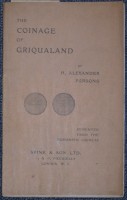 The Coinage of
Griqualand - H Alexander Parsons
The Coinage of
Griqualand - H Alexander Parsons
 This informative
and very rare booklet (see image right) is a must for any serious
collector of Griqua coins. A quick
search
on the Internet will reveal that Parsons wrote a large number of
numismatic articles for Spink (mainly on old English coins) at this time.
Even Spink now accept that Parson's research was
flawed.
This informative
and very rare booklet (see image right) is a must for any serious
collector of Griqua coins. A quick
search
on the Internet will reveal that Parsons wrote a large number of
numismatic articles for Spink (mainly on old English coins) at this time.
Even Spink now accept that Parson's research was
flawed.
The book is the basis of the misconception that the Griqua Town coins issued by the London Missionary Society's Rev John Campbell were South Africa's first currency. As demonstrated in the book "The Griquas of South Africa and their Money" (see below) they were never used in South Africa as coinage. Authoritative works like J T Becklake's "From Real to Rand" (see pg 12) and comments by Dr Frank Mitchell and more recently Brian Hern were based on the findings made in the flawed research in Parson's book.
As recently as 2008 Brian Hern in his catalogue on South African coins and patterns continued to suggest that the Griquatown coins did actually circulate - despite being aware of the evidence provided by Balson clearly showing this to be false!
The Balson Holdings Family Trust has a copy in excellent condition.
Critical comment on this work:This book sets out to prove that the Griqua Town coins issued by Rev J Campbell were actually used as currency in Griqua Town. The work is flawed although, historically, it is an interesting and rare document. This is the work on which so many authors on South African numismatics that followed based their comments about the Griqua Town coins being used as currency by the Griquas in 1815/16. |
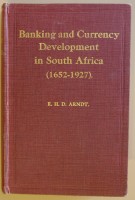 Banking and Currency
Development in South Africa -
Banking and Currency
Development in South Africa -
 Prof Arndt's books, including this
one, were used in universities in South Africa including the University of
Pretoria as an authoritative text book for BCOM students and he was considered
to be the author of South African banking / currency in South Africa.
Prof Arndt's books, including this
one, were used in universities in South Africa including the University of
Pretoria as an authoritative text book for BCOM students and he was considered
to be the author of South African banking / currency in South Africa.
This book is a comprehensive 500 page study of the banking and currency of South Africa from 1652 to 1927 (date of publication).
The book confirms Scott Balson's position that the
Griquatown coins never circulated.
Relevant extract (scanned in
images below pg 127):
The coins were of four denominations, viz: 1/4 and 1/2 in
copper and IIIII and 10 in silver. These were sent at a time when these coloured
people had not the slightest notion of the advantages of a metallic currency.
Moreover their entire trade at the time did not even amount to fifty pounds per
annum. Accordingly it is not surprising that "the dove of peace soon flew away and the
money of which never a single farthing was in circulation accompanied
it". The only permanent memorials of Campbell's visit turned out to be
the names "Griqua" and "Griquatown".
The Balson
Holdings Family Trust has a copy in excellent condition.
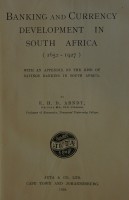
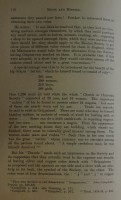
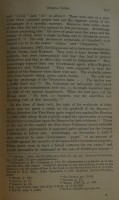
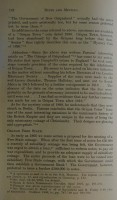
Critical comment on this work:The book, written by an authority on the subject on South African currency, completely contradicts the spurious claims of Parsons (see book above). |
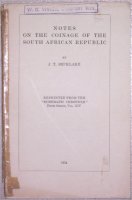 Notes
on the Coinage of the South African Republic - J T Becklake (1934)
Notes
on the Coinage of the South African Republic - J T Becklake (1934)

Becklake was the Director of the S African Mint.
This informative and extremely rare original 33 page booklet (see image right) was originally part of the W.G. "Don" Vivier of Beaufort West's Africana Book collection (as noted on the cover). The book comes with errata stuck to the first page.
The book has a personal letter dated in 1952 to Vivier signed by J T Becklake (see below). The letter is stuck onto the last page of the book. It is, like Parsons book above, a reprint of an earlier work taken from the Numismatic Chronicle - Fifth Series, Vol XIV
The book is one of the first works covering the early history of South Africa's coinage including the failed Griqua Town token coins. It makes no reference to the "Griqua Town coins of 1815/16".
The Balson Holdings Family Trust has a copy in good condition although the back and front cover has come loose.
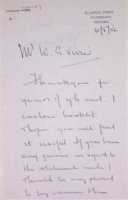 |
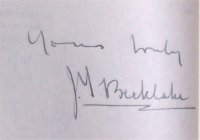 |
Critical comment on this work:A pioneering work by the man who later wrote the work "From Real to Rand". The book looks at the ZAR coinage including a lengthy chapter on the all important Veld Pond. |
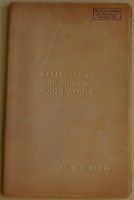 Catalogue of the coins of South Africa - Dr Alec Kaplan (1950)
Catalogue of the coins of South Africa - Dr Alec Kaplan (1950)

Kaplan's 28 page work was one of the first comprehensive catalogues of South African coins. Kaplan self-published the book which becanme the standard for those that followed later. He established his coin dealership, Alec Kaplan and Sons, in the same year - it is still trading today.
In the days this book was published a complete 1931 proof set was just twenty pounds and a 1931 tickey just three!
The book is bound in soft leather and has page separators throughout. There are many black and white images of coins. Interestingly the book makes no reference to the Griquatown coins seeing them (correctly) as playing no part in South Africa's numismatic history. That leap of faith came from Ms Shaw in her 1955 book "A history of currency in South Africa" below.
The inside front cover of the book has an inscription to Wynand from Willie dated 26th June 1963 - reflecting a birthday gift. It was originally owned by W G H Vivier from Beaufort West, as seen on the front cover. (See image right).
The Balson Holdings Family Trust holds a copy in excellent condition.
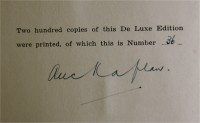 |
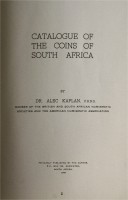 |
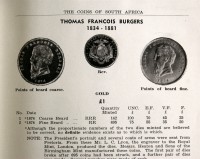 |
Critical comment on this work:A pioneering work by the man who later wrote the work "From Real to Rand". The book looks at the ZAR coinage including a lengthy chapter on the all important Veld Pond. |
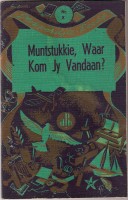 Muntstukkie, Waar Kom Jy Vandaan -
Muntstukkie, Waar Kom Jy Vandaan -

One of the first book's on South African coins and the first printed in Afrikaans.
Very rare - soft covered - 37 pages.
The book has it flaws. For example, it suggests that the Griquatown coins were the first currency issued in South Africa (based on Parson's flawed research). What is intriguing in the scans below is that Simpson suggests that the values of "Five" and "Ten" were tied up with the fingers on our hand (counting them) - whereas Hern suggests that this was the first attempt at a decimal system!
The Balson Holdings Family Trust holds a copy in excellent condition.
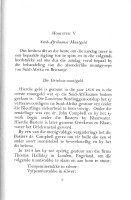 |
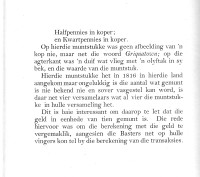 |
Critical comment on this work:A pioneering work by the man who later wrote the work "From Real to Rand". The book looks at the ZAR coinage including a lengthy chapter on the all important Veld Pond. |
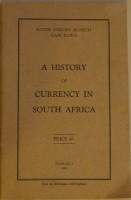 A history of currency in South Africa -
A history of currency in South Africa -

Interesting history of early South African coins although the author falls into the same trap about the Griquatown coins. She does however note that "they were not a success and withdrawn" which is better than suggesting they circulated at all!
Dr Alec Kaplan (1950) completely omits any reference to the Griquatown coins... see this link.
The Balson Holdings Family Trust has a copy in excellent condition.
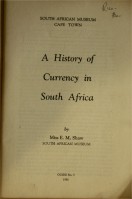 |
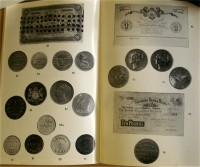 |
Critical comment on this work:Miss Shaw was a well respected researcher at the South African Museum in Cape Town and does a very good job with this book |
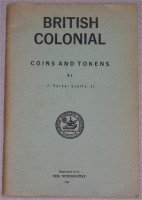 British Colonial Coins and Tokens by J
Verner Scaife jnr. Published 1962
British Colonial Coins and Tokens by J
Verner Scaife jnr. Published 1962
 Another example
of a numismatic work perpetuating H Alexander Parson's
flawed research.
Another example
of a numismatic work perpetuating H Alexander Parson's
flawed research.
The book (on page 56) refers to the Griqua Town coins being used by the Griquas in 1815/16 and then being melted down.... can you imagine retrieving the individual pieces from a remote part of the African bush, sending them back to London by boat then melting them down? This "melting down" story is apparently an explanation for the out of proportion numbers of silver to bronze pieces.
As detailed in Balson's book on the "Griquas of S Africa and their money" there was no way the Griqua's ever used these pieces as currency as claimed.
What is interesting is Scaife's reference to "an unscrupulous English collector who obtained the original dies and produced gold pieces in about 1920". Clearly, if this was the case, then the dies must have been created more recently than 1815 as argued by Balson and the mint examples of the Griqua Town coins now in collections might have been struck by the same "unscrupulous English collector" in 1920.
The flaws in Scaife's work are best represented by the claim in this book that "The word Griqua means a mixture of Boer and Hottentot blood". n Campbell's book he explains how the name "Griqua" was reached when he refers to the origin being abridged from the Hottentot tribe from which most Griquas originated - the "Gurirgiqua".
The Balson Holdings Family Trust has a copy in excellent condition.
Critical comment on this work:Perpetuates the myth that the Griqua Town coins were actually used by this remote and (then) uncivilised people. |
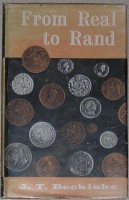 From Real to Rand, J
T Becklake published 1965
From Real to Rand, J
T Becklake published 1965
A very useful handbook detailing the early history of coinage and the history of S Africa's coinage (up to the introduction of the Rand).
It is flawed in its research on the Griqua Town coins as Becklake bases his placement of the Griqua Town coins in the book as S Africa's first coinage based on Parson's flawed research (see page 12).
As detailed in Balson's book on the "Griquas of S Africa and their money" there was no way the Griqua's ever used these pieces as currency as claimed.
The Balson Holdings Family Trust has a copy in excellent condition.
Critical comment on this work:Overall an excellent and sound history of S Africa's coinage (apart from the chapter on the Griqua Town coins). |
 One of a handful
of the first and only edition published in 1966 by
the Africana Museum in South Africa. It is a bulky book weighing over 2kg
and entitled "Tokens of Southern Africa. A Catalogue Based on the
Collection in the Africana Museum". The 233 page book details
the technical information of hundreds of tokens catalogued from the Africana
Museum and Colonel J L Knobel's collections. The tokens are listed
by South African state and include neighbouring states like Rhodesia.
One of a handful
of the first and only edition published in 1966 by
the Africana Museum in South Africa. It is a bulky book weighing over 2kg
and entitled "Tokens of Southern Africa. A Catalogue Based on the
Collection in the Africana Museum". The 233 page book details
the technical information of hundreds of tokens catalogued from the Africana
Museum and Colonel J L Knobel's collections. The tokens are listed
by South African state and include neighbouring states like Rhodesia.
The Balson Holdings Family Trust owns an extremely rare hard copy edition of this work in near mint condition with original binding of blue cloth with gilt edges. Most copies of the book found today are reprints made in the 1960s softbound in yellow paper covers and bound by staples.
Critical comment on this work:An excellent and comprehensive work by an accomplished librarian. The work details many of the South African tokens held in the Africana Museum and once held by Col Knobel. |
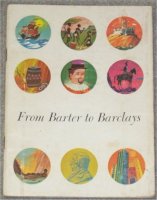 From Barter to Barclays -
Eric Rosenthal (1968)
From Barter to Barclays -
Eric Rosenthal (1968)
This excellent soft covered 50 page publication compiled by Eric Rosenthal for Barclays bank overviews the early history of coin and bank notes in South Africa.
The book starts off with a chapter about pre-white man currency (cowrie shells) and the early explorers and their trade.
Rosenthal's unique research in areas gives a clear insight between fact and fantasy when it come to the Griqua Town coins produced for Rev John Campbell! Although he is misguided by Parson's work his observations speak for themselves.
The scan below is taken from page 18 of the booklet in which Rosenthal claims the entire trade in the region at this time was "less than ZAR100 per annum". Balson's view is that this figure is dramatically inflated as, as Campbell stated in his second trip in 1819-1821, no (cash) trades ocurred - everything was by barter. Like the claim the Griquatown coins circulated in 1815-16 one has to go no further than common sense to see that this never happened.
The Balson Holdings Family Trust has two copies in excellent
condition.
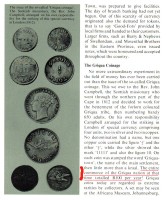
Critical comment on this work:Easy to read and loaded with useful facts and background to the history of South Africa's coinage. The sort of historical book that people of all ages would find interesting and informative. Provides telling evidence that the Griqua Town coins were never used as currency in 1815/16. |
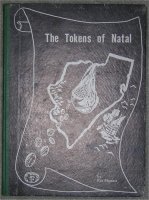
One of the first token coin books on South African tokens - includes comprehensive background on the Durban Club, Blackwood Couper tokens and A H Guy building contractor tokens amongst others.
Limited edition release - 500 copies.
The Balson Holdings Family Trust owns copies numbers 99, 169 and 219 which
are all in excellent condition.
Critical comment on this work:Moran gets distracted from the main focus of his title with page after page of irrelevant documentation about the early railways in Natal. Despite this fact the book does contain some information that will be of interest to serious numismatists. |
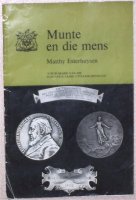 Munte en die Mens by Matthy Esterhuysen.
Published 1970
Munte en die Mens by Matthy Esterhuysen.
Published 1970
 A very rare 32 page
soft cover book in Afrikaans.
A very rare 32 page
soft cover book in Afrikaans.
Matthy Esterhuysen is better known for her excellent 1976 work on the Burgers Pond.
This book looks at the very early coinage circulating in Southern Africa (including trade tokens)... it also includes the Veld Pond , ZAR coinage and Burgers Pond. Like others that follow the book erroneously refers to the Griqua Town coins circulating in 1815/16. It is clear from her remarks that her comments are drawn from Parson's 1927 work. It is also worth noting that Esterhuysen is the first author to try and justify the fact that the bronze Griqua Town coin is scarcer than the silver pieces. She says on page 11 that the coins were melted down and, in the case of the bronze coins, they were unpopular with the Griquas as they "were not shiny". The basis of this extraordinary assumption is not known or explained. Below is a transcript from this page with the relevant words highlighted:
Die eerste uitgawe van tekengeld in Suid-Afrika is deur die Londense Send ingvereniging in 1815-1816 uitgereik vir gebruik onder die Griekwas. Hierdie uitgawe is heelwaarskynlik die eerste munting van Sendinggeld in die wereld. Dit was vir ongeveer twee jaar in gebruik; daarna is die Griekwageld opgesmelt omdat die Griekwas nie in staat was om die waarde van geld to leer nie. Slegs 'n klein hoeveelheid Griekwageld het behoue gebly en sover bekend, is daar net vier muntversamelings in ons land waarin volledige stelle van hierdie Griekwamunte is. Die koper muntstukke is skaarser as die van silwer en daaruit kan moontlik afgelei word dat minder koper munte geslaan is, waarskynlik omdat die Griekwas die blinker munte verkies het bo die dowwer, roof koper stukke. Daar bestaan egter 'n verskil van mening: sommige versamelaars reken dat die Griekwageld die amptelike wisselkoers was en ander meen weer dat dit niks meer as net tekengeld was nie.
The Balson Holdings Family Trust has a copy in excellent condition.
Critical comment on this work:Interesting work - but in Afrikaans so a knowledge of this language is important. The comments about the Griqua Town coins - reproduced above - are flawed. |
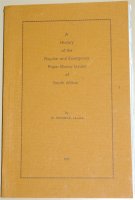 A history of the regular and emergency paper money issues of
South Africa W Bergman.
A history of the regular and emergency paper money issues of
South Africa W Bergman. This is the second edition revised and upgraded from the first edition published in 1968.
The 66 page book is bound in its original orange paper cover and has a large number of images.
Bergman gives an interesting account of the early history of South African bank notes.
The Balson Holdings Family Trust has a copy in excellent condition.
Critical comment on this work:Interesting work covering a wide range of bank notes including the one pound of the Griqua (comments above) and the Siege of Mafeking. |
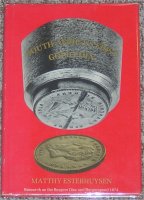 South Africa's First Gold Coin
(Burgerspond)
South Africa's First Gold Coin
(Burgerspond)The book held by the Balson Holdings Family Trust is in excellent condition and is signed by the author.
Quote: "The Burgers "staatspond" of 1874 was the first coin struck for a South African government. It was made from some of the first gold ever found in the country which was to become the world's richest source of this precious metal. It is one of the greatest rarities in the whole South African coinage series."
The book reveals that the first batch of 695 Burgerpond's (fine beard) was delivered on 25th July 1874 with the second (rarer) batch of 142 (coarse beard) gold coins delivered on 23rd October of the same year.
Interestingly, the first issue of the Strachan and Co trade tokens was already in general circulation at this time as currency in Nomansland in a large area between the Drakensberg and the east coast of South Africa. Unlike the Bugerspond their use extended over 50 years.
The Balson Holdings Family Trust's fine beard Burgers Pond can be seen
at this link.
Critical comment on this work:It is informative to note that the author states that only a small portion of the gold sent for minting the coins was used - it is clear that the Burgerspond was not accepted by all Afrikaners and that some ill-feeling was shown in the Volksraad (government) in 1874. The small numbers of the coin reflect the lack of success in introducing this coinage. Their lack of success, reflected by most Burgerspond's being damaged by landing up as ornamental jewellery, is at the other end of the scale to the incredibly successful currency issued by Strachan and Co for the people of Nomansland. |
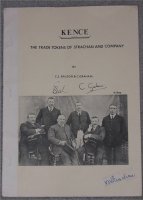 Kence, the trade tokens of
Strachan & Co -
Kence, the trade tokens of
Strachan & Co -
 The extremely rare 30 page Africana book "Kence" the trade
tokens of Strachan and Company by C S Balson and C Graham
(1978) which is partly transcribed from the links
at this page can be found in some of the world's major libraries
like the Afrikaner Library in Johannesburg. This book received the solid
endorsement of Ken Strachan, grandson of Donald Strachan (See
page one, page two
of his letter in which he orders 30 copies).
The extremely rare 30 page Africana book "Kence" the trade
tokens of Strachan and Company by C S Balson and C Graham
(1978) which is partly transcribed from the links
at this page can be found in some of the world's major libraries
like the Afrikaner Library in Johannesburg. This book received the solid
endorsement of Ken Strachan, grandson of Donald Strachan (See
page one, page two
of his letter in which he orders 30 copies).
The thumbnail image right is of one of only ten signed copies of the book "Kence, the trade tokens of Strachan and Co". The book shown here was signed by the authors Balson and Graham in 1978 and endorsed under the Strachan and Co company stamp by Ken Strachan in the bottom right corner.
The thirty copies ordered by Ken Strachan were distributed to Directors in the company as well as the Prime Minister of the Transkei and the Killie Campbell Library. The Balson Holdings Family Trust was able to secure one of these books (#87 of 500) inscribed by Ken Strachan with the words "With the compliments of the Directors of Strachan and Co Ltd - October 1978". (See image below right). The book was acquired from Pietermaritzburg Numismatist Michael Laidlaw. It was purchased by him at an auction in Durban of Guy Scott's belongings in May 2005. (Guy Scott was a director in Strachan and Co).
Originally 1,000 copies were printed - 850 were burnt in a fire in the Drakensberg leaving just 150 copies.
Image right below: Prof Clive Graham who passed away in June 2010
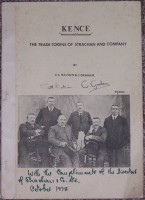

The books shown here form part of the Balson Holdings Family Trust collection which owns twenty other copies. The Balson Holdings Family Trust also owns the original manuscript of the book which was used to self-publish the copies - See this link for more
Errata to "Kence": per Margaret Rainier through Tom Mullins:
Critical comment on this work:The first work of its kind detailing the fascinating history of the Strachan family and their coinage, the Strachan and Co token coins. A very rare work that has not been seen on auction for many, many years. |
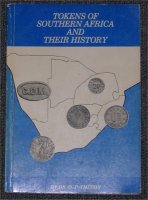 Scott Balson assisted Dr Theron in the compilation of this
book on S African tokens (see inside sleeve of the book). Dr Theron
a retired doctor was an avid numismatist and token coin collector living
in Gouritsmond in the Cape Province. His book printed by Magill and Mackenzie
Pty Ltd in Johannesburg in 1978 remains the authoratitive guide to South
African tokens at this time. The book was distributed by P&G Coins in
Johannesburg - it is very scarce today but a wonderful handbook. Where applicable
we have used Dr Theron's reference to the tokens displayed on this web site.
You will see that we make reference to correspondence with Dr Theron in coverage
of the F C Larkan
tokens. The Balson Holdings Family Trust still has a
large amount of Dr Theron's original
correspondence! In the letter scanned at these links below you can
see Theron's initial response to research on various token coins and his
argument that there are only three sets of Strachan and Co (see the links
"Are there four sets
of Strachan and Co?")
Scott Balson assisted Dr Theron in the compilation of this
book on S African tokens (see inside sleeve of the book). Dr Theron
a retired doctor was an avid numismatist and token coin collector living
in Gouritsmond in the Cape Province. His book printed by Magill and Mackenzie
Pty Ltd in Johannesburg in 1978 remains the authoratitive guide to South
African tokens at this time. The book was distributed by P&G Coins in
Johannesburg - it is very scarce today but a wonderful handbook. Where applicable
we have used Dr Theron's reference to the tokens displayed on this web site.
You will see that we make reference to correspondence with Dr Theron in coverage
of the F C Larkan
tokens. The Balson Holdings Family Trust still has a
large amount of Dr Theron's original
correspondence! In the letter scanned at these links below you can
see Theron's initial response to research on various token coins and his
argument that there are only three sets of Strachan and Co (see the links
"Are there four sets
of Strachan and Co?")
Here is this copy of Theron's letter (dd 21st June 1977):
page one;
page two;
page three,
page four.
The Balson Holdings Family Trust has a signed copy of Dr Theron's book
(#22) and the valuation addenda given to tokens by Theron back in the 1970s
and 80s.
Critical comment on this work:The first comprehensive work on South African tokens following the book by Maynard. Theron's book adds more flesh to the background of coins and, more importantly, gave the first indicative pricing on tokens from this region. |
In this article Mitchell suggests that the coins did actually arrive in the community but that they were "confused" and were never used as currency.
Quote (pp105):
John Campbell's dream of a thriving commercial
centre did not materialise. Indeed, the primitive Griquas must have been
confused to know what to do with their new "coins".
They had no real use for money
and it seems doubtful if the coins ever
circulated. According to Halliday's
later comments , most of the Griqua own issue was soon returned to England
and melted own in the face of the fluctuating value of silver in the wake
of the Napoleonic wars.
Critically Mitchell notes that there has only been one report of a Griqua Town coin being found in South Africa (near Matjiesfontein).
The Balson Holdings Family Trust holds a copy of the article.
Critical comment on this work:Mitchell throws some interesting light on the total impracticality of the Griqua Town coins ever being used by the Griquas. (See this artists impression of a typical Griqua family home at Griqua Town in 1834 - 20 years after the coins were allegedly used.) From our research it is more likely that these 1815/1816 token coin pieces only hit South African shores in 1820 and were a complete failure. Halliday's comment that they were withdrawn and melted down is clearly an attempted explanation as to why no Griqua Town coins have been found on the hands of the Griqua people. Unfortunately Mitchell also draws his presumptions largely from Parson' earlier flawed work. See Mitchell's article with Balson's notes at these links: Page one, Page two, Page three. |
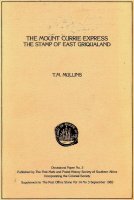 The Mount Currie Express, the stamp of East
Griqualand -
The Mount Currie Express, the stamp of East
Griqualand - In this comprehensive 32 page book published by the Postmark and Postal History Society of Southern Africa Mullins discusses the fascinating history of the extremely rare Mt Currie Express Stamp issued by the Ballance and Goodliffe trading store at Mount Currie a few miles from Kokstad.
Quote (pp 3):
The fact that so little is known of the Mount
Currie Express stamp, and that copies so seldom appear on the philatelic
market, persuaded me it would provide a fascinating subject for both historical
and philatelic research. My efforts have proved this to be correct, and I
have frequently found myself pursuing avenues of enquiry far removed from
what I was seeking, and sometimes only with difficulty was I able to return
to more relevant paths.
The whole exercise has, however, proved to be an admirable example of genuine postal history, particularly in relation to the circumstances giving rise to the need for a "local" or "carrier" stamp. The fact that it existed in a sovereign Griqua state, in pioneering and almost primitive conditions, adds to its romance.
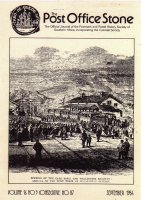 The Balson Holdings Family Trust holds
a copy of the rare book inscribed by the
author and owns a pair of the Mount Currie
Express stamps.
The Balson Holdings Family Trust holds
a copy of the rare book inscribed by the
author and owns a pair of the Mount Currie
Express stamps.
More on the Mount Currie Express One Penny Stamp at this link
The author, Tom Mullins, through his shared interest in the peoples of East Griqualand, sold his collection of related books to the Balson Holdings Family Trust in September 2005. Of particular interest is the September 1984 edition of The Post Office Stone (Volume 16 No 3 Consecutive No 87) (seen right) in which Tom Mullins refers (on page 9) to an earlier (1869) postal service running from Mount Currie - before the Griquas moved to Kokstad.
Also included is a 1989 letter of acknowledgement from the librarian of the Cory Library for Historical Research at Rhodes University in Grahamstown for Mullins' working papers and a Certificate of Merit awarded to Mullins for his work on the Mount Currie Express stamp.
This very rare copy of The Post Office Stone carries a lengthy article by Tom Mullins and facsimiles of documents dated between February and May 1869 refering to an earlier postal service between Mount Currie and Umzimkulu... interestingly the then Griqua Secretary and (later) partner in Strachan and Co, George Brisley, is noted as the Postmaster!
Apparently no postage stamp was issued in 1869.
Critical comment on this work:
Fascinating document
and well worth acquiring. The major point that I dispute with Mullins is
his claim that the stamps were never recognised by the Griqua
Government.
Image right: A rare pair of Mount Currie Express stamps owned by the Balson Holdings Family Trust Robert Ross in Adam Kok's Griquas refers to traders like J P Scott and T O Hall being chased out of East Griqualand for failing to conform and, the various references in the (Cape) Government Papers (G58 of 1878) note how the Griqua Raad came down hard on businesses (especially white owned) that did not comply with their rulings. On page 113 or Ross's book he states: Such was its (the Raad's) power that at least one trader J P Scott decided to cease operations in the region when he fell foul of Brisley, the secretary while trading rivalries were probably of great importance in the expulsion of T O Hall by the Griquas in 1872. Such was the power accruing from control over the Griqua polity. It is clear that the Griqua Raad availed of these stamps as much as citizens did - the Raad had no infrastructure to support a postal system and would have, like Strachan's trade tokens as currency, welcomed and recognised Ballance and Goodliffe's one penny stamps. In fact the greatest pointer to the Mount Currie Express stamps being approved by the Griqua Raad is the overwhelming evidence that the Griquas accepted the trade tokens of Strachan and Company as their currency in the same year - 1874. And why not? Stamps and coin at no cost to a near-bankrupt government - why would they not embrace such useful services in such an isolated region? |
This excellent work gives an expanded history into the background of money in South Africa, it does not however give coin valuations.
It hardly touches on the post World War One notes and coin reflecting more on the origins of money in South Africa and giving valuable insights into some of the challenges faced in trying to produce money during times of war (eg the Veld Pond). The book "The South African Coin and Banknote Catalogue (2002-2003)" fills this gap.
In Chapter 19 it makes special reference to the Strachan and Co trade tokens and their important role as currency in East Griqualand from 1874 to 1932.
Special mention is made by the author of Volkskas Bpk (a South African Bank) who assisted him in producing the book
The Balson Holdings Family Trust has a copy of the book in mint condition.
Critical comment on this work:The finest numismatic book covering the entire history of coinage and bank notes in South Africa. Strongly recommended to students of South African coins and bank notes. It does however, like many other numismatic books, fall foul of those immortal words "the experiment was not a success" when trying to justify the furphy that the Griqua Town coins (1815-1816) were South Africa's first currency. These coins were never circulated in South Africa. |
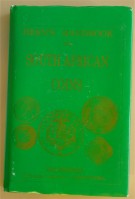 Useful
277 page hard copied reference work but wrongly suggests that the Griquatown
coins circulated as currency in South Africa. The same points listed in the
2008 Hern book on the same subject are carried.
Useful
277 page hard copied reference work but wrongly suggests that the Griquatown
coins circulated as currency in South Africa. The same points listed in the
2008 Hern book on the same subject are carried.
You can see why the points are incorrect by taking this link.
The copy shown here has original covers and is in near mint conrition.
The Balson Holdings Family Trust has a copy of the book in mint condition.
Critical comment on this work:Useful reference work |
 This
useful handbook on South African coins runs to 320 pages.
This
useful handbook on South African coins runs to 320 pages.
The valuations given in the book cover the more traditional numismatic pieces such as ZAR, post 1923 and South African Reserve Bank notes.
Sadly, very little information of value is supplied on the real treasures of South African numismatics such as the early coinage of the Cape, the Griqua coinage and note or other pre-1900 bank notes.
This is what makes Engelbrecht's book "Money in South Africa" our first preference when it comes to an overall history of numismatics in South Africa and Krause's various books on South African coin and bank notes of more value when it comes to the broader valuations of numismatic pieces.
The Balson Holdings Family Trust has a copy of the book in mint condition.
Critical comment on this work:While technically accurate this book, like many others, falls foul of those immortal words "the experiment was not a success" when trying to justify the furphy that the Griqua Town coins (1815-1816) were South Africa's first currency. These coins were never circulated in South Africa. |
 The Griquas of South Africa and
their money - S Balson (February 2004)
The Griquas of South Africa and
their money - S Balson (February 2004)
 An extraordinary
work based on 25 years of collection and research into these little understood
people. The book factually exposes the romantic theories about the Griqua
Town coins minted in 1815. The 50 page book carries much of the information
displayed on this web site but provides more detail on other coins used by
the Griqua people. There are ten pages of colour plates which include historic
photographs and coins. An overview and order form
can be seen at this link.
An extraordinary
work based on 25 years of collection and research into these little understood
people. The book factually exposes the romantic theories about the Griqua
Town coins minted in 1815. The 50 page book carries much of the information
displayed on this web site but provides more detail on other coins used by
the Griqua people. There are ten pages of colour plates which include historic
photographs and coins. An overview and order form
can be seen at this link.
The first 20 copies are numbered, signed and have 3d Strachan and Co "In Goods" token strung on a leather bookmark.
The Balson Holdings Family trust owns #1 as well as several other of the
first 20 copies.
Critical comment on this work:A very focused work, well researched, which reveals the important role of the Strachan and Co tokens as part of South Africa's evolving currency. |
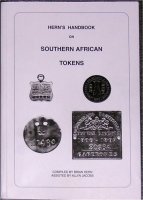 Handbook on Southern African tokens by Brian Hern (April
2004).
Handbook on Southern African tokens by Brian Hern (April
2004).
Softcover, over 300 pages, with several full page advertisements of South African coin dealers.
This work by Hern, assisted by well known South African numismatist Allyn Jacobs, aims at assisting the exploding numbers of token coin collectors in the complex area of South African tokens. It is, without question, the most complete work of Southern African tokens ever produced, but the focus of the book in providing current values is highly defective, as admitted by one of the men listed above to Scott Balson.
This is an important issue as Hern notes "Prices are a contentious issue" while Bowles of P&G Coins confirms that many of the prices on tokens listed in the book are highly undervalued.
Despite this flaw the book is a very useful work in identifying a range of previously unknown pieces.
The first edition of this book held by the Balson Holdings Family Trust is inscribed and signed by both Brian Hern (17th April 2004) and Allyn Jacobs.
Critical comment on this work:There are serious concerns about the agenda of this work in promoting tokens being held by Brian Hern's "The Coin Shoppe" shown in the book such as a cardboard "discount piece" of unknown origin as being more valuable than one of the first edition S&Co pieces (1/-). If you have a copy of this book your references are item 674a on page 251 (the cardboard token of unknown origin) v item 582b on page 219). We hope that the author of this work is able to correct these glaring anomalities which discredit the primary purpose of this publication as a guide to token coin values. |
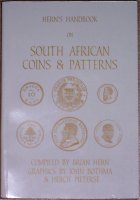 South African
Coins and Patterns by Brian Hern (March 2006).
South African
Coins and Patterns by Brian Hern (March 2006).
Softcover, over 350 pages, with several full page advertisements of South African coin dealers.
This work by Hern, carries a lot of useful information and pricing on contemporary South African coins but comes unstuck when it, once again, promotes the idea that the Griqua Town coins were actually used in 1815. This casts a shadow on much of his published material on the pre-Boer war pieces.
We have formally written to Brian Hern (March 2006) advising him of the facts which clear show that this is nothing more than a fantasy.
Proof that the Griquatown tokens never circulated at this link..
Mr Hern's extraordinary response can be seen at this link
In his 2008 edition Hern continued the
ridiculous fallacy....
|
This book is held by the Balson Holdings Family Trust.
Critical comment on this work:Despite its obvious inaccuracies on page 274 (comments 1 to 12) about the Griqua Town coins are totally false and based on Parson's earlier flawed findings the book is a useful reference guide. Brian Hern's dismissive response to the latest research can be seen at this link.. |
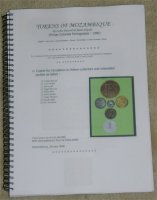 Tokens of Mozambique - Allyn Jacobs (2006)
Tokens of Mozambique - Allyn Jacobs (2006)
 This soft covered,
ring bound book is but one of just ten copies self-published by well-known
Johannesburg numismatist Allyn Jacobs. It is the translation of an original
work c1990 by A translation of the original work by Salgado & Pascoal
This soft covered,
ring bound book is but one of just ten copies self-published by well-known
Johannesburg numismatist Allyn Jacobs. It is the translation of an original
work c1990 by A translation of the original work by Salgado & Pascoal
The A4 sized 70 page book is loaded with information, maps and images of old Mozambique, stamps, token coins and people and is an invaluable resource for any collector of token coins from this region.
Some of the pages from the book are shown below.
The Balson Holdings Family trust owns #2 inscribed by the author
Allyn Jacobs.
Critical comment on this work:A fascinating insight into the early days of Mozambique and the region's money |
Tokens of the Transkei -
Milner Snell 2007
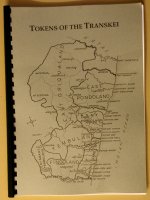
 This book is just one of ten with colour plates produced by
Milner Snell. It was personally handed to Scott Balson in October 2007
during the launch of his book "Children
of the Mist". In total twenty copies were produced by Milner Snell
- the other ten having mono plates.
This book is just one of ten with colour plates produced by
Milner Snell. It was personally handed to Scott Balson in October 2007
during the launch of his book "Children
of the Mist". In total twenty copies were produced by Milner Snell
- the other ten having mono plates.
The quality of this work, like Snell's earlier works, belies this limited production.
The book covers the tokens and related history of tokens including:
Strachan and Co
F C Larkan
James Cole
Dawood Amod and Co
W W Philips
The copy held by the Balson Holdings Family Trust has been signed by Milner Snell.
Critical comment on this work:An excellent work - if I do have an issue with this book it is that Milner suggests that the use of the Strachan and Co tokens was limited to the area in which their stores were located. On page 53 Milner states: "The geographical area over which the Strachan tokens were accepted is often overstated". He then suggests that the tokens were only used in the Umzimkhulu region in the early days where most of the Strachan stores were located. It is clear that from the very start (1875) the name of Donald Strachan carried immense credibility. The Standard Bank in Kokstad state that the tokens were accepted as currency when they opened their branch there - and this acceptance clearly spread across a far wider region. |
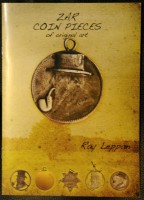 ZAR Coin Pieces of
original art (2008)
ZAR Coin Pieces of
original art (2008)Fascinating soft covered full colour A5 brochure like booklet with over 100
examples of coin trench art from the Boer war era. (see image
below).
This is what Peter Digby has to say about Ray
Leppan's Boer War collection "To visit Ray Leppan and view his Anglo - Boer war
collection is not only a rare experience but a privilege. I know of no other
collection that embraces all aspects of the memorabilia and collectibles of the
war."
The book is inscribed by Ray Leppan
This book held by the Balson Holdings Family Trust is inscribed and signed by Ray Leppan.
You can see examples of trench art coins held by the Balson Holdings Family Trust at this link
Example of a page in the bookbelow:
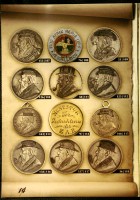
Critical comment on this work:Excellent work - the Balson Holdings Family Trust of trench art coins can be seen at this link. |
 Hern's Handbook on Southern African tokens
Hern's Handbook on Southern African tokensSoftcover, over 300 pages, with several full page advertisements of South African coin dealers.
This work by Hern, assisted by well known South African numismatist Allyn Jacobs, aims at assisting the exploding numbers of token coin collectors in the complex area of South African tokens. It is, without question, the most complete work of Southern African tokens ever produced.
This book is a very useful work in identifying a range of previously unknown pieces despite its flaws. The new indexing makes it easier to find some of the more obscure pieces than the 2005 book.
The first edition of this book held by the Balson Holdings Family Trust is inscribed and signed by both Brian Hern and Allyn Jacobs.
Critical comment on this work:Like the first 2005 edition there are serious concerns about the book as a guide to token coin values. These concerns have been confirmed in the prices of token coins achieved on the South African online auction website BidorBuy in 2010. Strachan, Durban Club and F C Larkan tokens were sold on auction at 300% plus over the prices suggested in Hern. |
Tokens of the Transkei -
Milner Snell 2010
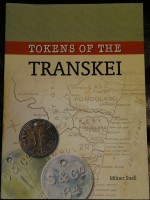
 This book is just one of ten with colour plates produced by Milner Snell. In total sixty copies of this update of his 2007 book on the "Tokens of Transkei". Just ten were printed in colour (the balance in black and white).
This book is just one of ten with colour plates produced by Milner Snell. In total sixty copies of this update of his 2007 book on the "Tokens of Transkei". Just ten were printed in colour (the balance in black and white).
The soft covered book runs to 50 pages and has several colour plates of tokens. Unfortunately the true colour of the tokens is sometimes lost in the images but apart from this minor issue this is without doubt the most comprehensive single work on all of the tokens of Transkei.
The quality of this work, like Snell's earlier works, belies this limited production.
The book covers the tokens and their related history including:
The three colour copies, numbered 3 to 5 of 10, held by the Balson Holdings Family Trust have been signed by Milner Snell.
Critical comment on this work:As usual an excellent work - updating much of the original 2007 book and adding a large number of new stores who issued trading token coins. Well done Milner! |
Tokens of the Colony & Province of Natal -
Milner Snell 2010
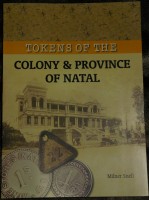
 This book is just one of ten with colour plates produced by Milner Snell. In total sixty copies of this were issued. Ten were printed in colour.
This book is just one of ten with colour plates produced by Milner Snell. In total sixty copies of this were issued. Ten were printed in colour.
The soft covered book runs to 90 pages and has several colour plates of tokens. It is beautifully produced. There are many of the tokens of Natal displayed in the book; and it is without doubt the most comprehensive single work on the tokens of Natal to date. Allyn Jacobs played a major role in assisting Milner with the book - this is recognised in the dedication.
The quality of this work, like Snell's earlier works, belies this limited production.
The book covers the tokens and their related history including:
The three colour copies, numbered 3 to 5 of 10, held by the Balson Holdings Family Trust have been signed by Milner Snell.
Critical comment on this work:The combined research of Milner and Allyn provides us with a lot of new understanding in the early tokens of Natal making it by far the most comprehensive work on this subject to date. |